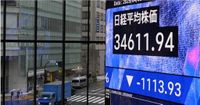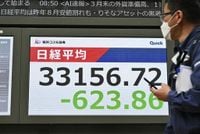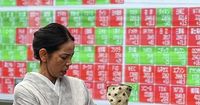On April 7, 2025, global financial markets faced a tumultuous day as a result of U.S. President Donald Trump’s recently announced tariff policies, which sent shockwaves through stock exchanges worldwide. The Taiwan stock market opened with a staggering drop of over 2000 points, triggering a limit down to 19167 points. This significant decline marked a dramatic fall from the previous day’s closing of 21302 points, reflecting the intense market reaction to Trump’s announcement.
Trump declared on April 2 that he would impose a 10% benchmark tariff on all imported goods, alongside higher tariffs for specific trading partners, including a notable 32% tariff on Taiwan. This sweeping tariff policy has led to widespread concerns among investors about potential economic fallout, as Taiwan Semiconductor Manufacturing Company (TSMC) saw its American Depository Receipts (ADRs) plummet nearly 14% during the two trading days of the Qingming holiday.
In response to the market turmoil, Premier Cho Jung-tai convened a meeting with finance officials on April 5, urging them to stabilize the stock and currency markets. The Financial Supervisory Commission (FSC) took decisive action by implementing what has been described as the strictest short-selling restrictions in history. This included drastically reducing the daily intraday lending volume for investors from 30% of the previous 30-day average to just 3%, while also raising the margin deposit ratio from 90% to 130%. These measures are set to remain in effect from April 7 to April 11, 2025, for a total of five days.
Despite these efforts, the Taiwan stock market still faced an immediate limit down at the opening bell, highlighting the severity of the situation. The panic was not isolated to Taiwan; the Tokyo stock market also opened lower, with the Nikkei index falling dramatically. It experienced a drop of over 2900 points during intraday trading, breaking below the psychologically significant 31000-point barrier, and closing the day at a new low of 34735 points, down 989 points or 2.77%.
Investor anxiety was palpable as markets reacted to the uncertainty surrounding the tariff announcements. The Dow Jones Index in the U.S. had already plunged over 2000 points in the preceding week, setting off a chain reaction of selling across global markets. In Japan, the Nikkei index opened down 684 points and quickly fell below 35000, reaching a low of 34102 points before recovering slightly. Banking stocks were particularly hard hit, with Mitsubishi UFJ and Sumitomo Mitsui down 7.2% and 7.7%, respectively. Automotive stocks also suffered, with Toyota falling by 5.2%.
In South Korea, the KOSPI index faced similar turmoil, triggering the 'Side Car' mechanism, which temporarily halted trading due to significant fluctuations. The KOSPI index fell 108.14 points, or 4.39%, leading to a five-minute trading suspension. This was reminiscent of the previous year’s ‘Black Monday’ on August 5, when the South Korean market also experienced extreme volatility due to global economic concerns.
The situation was exacerbated by China’s announcement of retaliatory tariffs on U.S. goods, further escalating fears of a trade war and potential global recession. Analysts pointed out that this escalation in trade tensions could have long-lasting effects on the global economy, causing widespread panic among investors. The combination of Trump’s tariffs and China’s countermeasures has led to a climate of uncertainty, prompting many investors to adopt risk-averse strategies.
As the day progressed, the Nikkei futures index experienced a dramatic drop of over 8% within the first ten minutes of trading, prompting the Osaka Exchange to implement a futures circuit breaker. This marked the first time since August of the previous year that such drastic measures were needed, a reflection of the market’s extreme volatility.
In summary, April 7, 2025, stands as a stark reminder of the fragility of global markets in the face of aggressive trade policies. The immediate impacts of Trump’s tariff announcements have reverberated through major economies, leading to significant declines in stock markets across Asia and raising concerns about the potential for a prolonged period of economic instability. Investors are left to navigate a landscape fraught with uncertainty as they await further developments in the escalating trade tensions between the U.S. and its trading partners.







